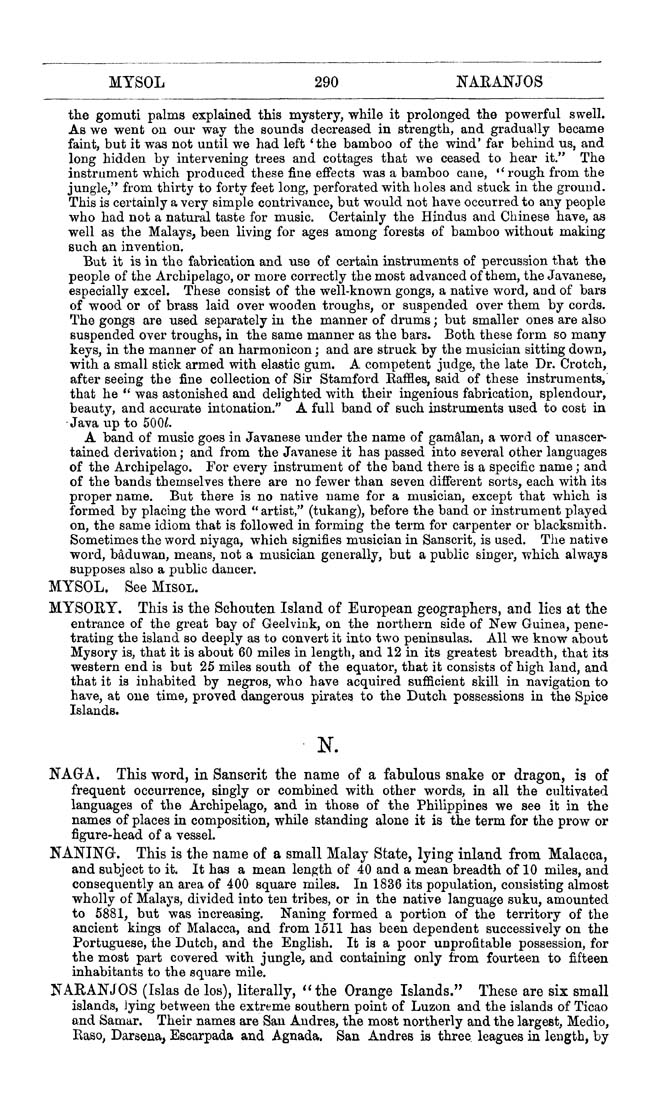MYSOL 290 NAEANJOS
the gomuti palms explained this mystery, while it prolonged the powerful swell.
As we went on our way the sounds decreased in strength, and gradually became
faint, but it was not until we had left 'the bamboo of the wind' far behind us, and
long hidden by intervening trees and cottages that we ceased to hear it." The
instrument which produced these fine effects was a bamboo cane, "rough from the
jungle," from thirty to forty feet long, perforated with holes and stuck in the ground.
This is certainly a very simple contrivance, but would not have occurred to any people
who had not a natural taste for music. Certainly the Hindus and Chinese have, as
well as the Malays, been living for ages among forests of bamboo without making
such an invention.
But it is in the fabrication and use of certain instruments of percussion that the
people of the Archipelago, or more correctly the most advanced of them, the Javanese,
especially excel. These consist of the well-known gongs, a native word, and of bars
of wood or of brass laid over wooden troughs, or suspended over them by cords.
The gongs are used separately in the manner of drums; but smaller ones are also
suspended over troughs, in the same manner as the bars. Both these form so many
keys, in the manner of an harmonicon; and are struck by the musician sitting down,
with a small stick armed with elastic gum. A competent judge, the late Dr. Crotch,
after seeing the fine collection of Sir Stamford Rafldes, said of these instruments,
that he *' was astonished and delighted with their ingenious fabrication, splendour,
beauty, and accurate intonation." A full band of such instruments used to cost in
Java up to 500^.
A band of music goes in Javanese under the name of gamMan, a word of unascer¬
tained derivation; and from the Javanese it has passed into several other languages
of the Archipelago. For every instrument of the band there is a specific name; and
of the bands themselves there are no fewer than seven different sorts, each with its
proper name. But there is no native name for a musician, except that which is
formed by placing the word " artist," (tukang), before the band or instrument played
on, the same idiom that is followed in forming the term for carpenter or blacksmith.
Sometimes the word niyaga, which signifies musician in Sanscrit, is used. The native
word, b^duwan, means, not a musician generally, but a public singer, which always
supposes also a public dancer.
MYSOL. See Misol.
MYSOEY. This is the Schouten Island of European geographers, and lies at the
entrance of the great bay of Geelvink, on the northern side of New Guinea, pene¬
trating the island so deeply as to convert it into two peninsulas. All we know about
Mysory is, that it is about 60 miles in length, and 12 in its greatest breadth, that its
western end is but 25 miles south of the equator, that it consists of high land, and
that it is inhabited by negros, who have acquired sufficient skill in navigation to
have, at one time, proved dangerous pirates to the Dutch possessions in the Spice
Islands.
• N.
NAGA. This word, in Sanscrit the name of a fabulous snake or dragon, is of
frequent occurrence, singly or combined with other words, in all the cultivated
languages of the Archipelago, and in those of the Philippines we see it in the
names of places in composition, while standing alone it is the term for the prow or
figure-head of a vessel.
NANING. This is the name of a small Malay State, lying inland from Malacca,
and subject to it. It has a mean length of 40 and a mean breadth of 10 miles, and
consequently an area of 400 square miles. In 1836 its population, consisting almost
wholly of Malays, divided into ten tribes, or in the native language suku, amounted
to 6881, but was increasing. Naning formed a portion of the territory of the
ancient kings of Malacca, and from 1511 has been dependent successively on the
Portuguese, the Dutch, and the English. It is a poor unprofitable possession, for
the most part covered with jungle, and containing only from fourteen to fifteen
inhabitants to the square mile.
NAEANJOS (Islas de los), literally, **the Orange Islands." These are six small
islands, lying between the extreme southern point of Luzon and the islands of Ticao
and Samar. Their names are San Andres, the most northerly and the largest. Medio,
Rase, Darsena, Escarpada and Agnada. San Andres is three leagues in length, by
|








